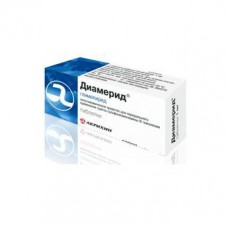Expiration date: 05/2026
Composition
Glimepiride 1, 2, 3 or 4 mg
Excipients: lactose monohydrate, povidone, poloxamer, croscarmellose sodium, cellulose microcrystalline, magnesium stearate, colorant iron oxide red.
Packaging
30 PCs
Pharmacological action
Diamerid - oral hypoglycemic drugs - derived sulfonylureas of the III generation.
Glimepiride acts mainly by stimulating the secretion and release of insulin from beta-cells of the pancreas (pancreatic effect). As with other sulfonylurea derivatives, the basis of this effect is the increase in reaction &,beta-cells of the pancreas at physiological glucose stimulation, whereas the amount of secreted insulin is significantly less than with conventional drugs - derived sulfonylureas. The least stimulating effect of glimepiride on insulin secretion and provides less risk of hypoglycemia.
In addition, glimepiride extrapancreatic action has the ability to improve the sensitivity of peripheral tissues (muscle, fat) to the action of insulin, reduce absorption of insulin by the liver, inhibits glucose production in the liver. Glimepiride selectively inhibits COX and reduces the transformation of arachidonic acid to thromboxane A2, which promotes platelet aggregation, thus exerting antiplatelet effect.
Glimepiride helps to normalize lipid content, reduces the concentration of malonic aldehyde in the blood, which leads to a significant reduction of lipid peroxidation that contributes to the antiatherogenic effect of the drug.
Glimepiride increases the level of endogenous &alpha,-tocopherol, catalase, glutathione peroxidase and superoxide dismutase, thereby reducing the severity of oxidative stress in the patient, which is always present in diabetes type 2 diabetes.
Testimony
- Diabetes type 2 diabetes the ineffectiveness of the previously assigned diet and exercise.
- With the ineffectiveness of monotherapy with glimepiride its possible use in combination therapy with Metformin or insulin.
Contraindications
- diabetes mellitus type 1,
- diabetic ketoacidosis, diabetic precoma and coma
- of state, accompanied by malabsorption of food and hypoglycemia (including infectious diseases),
- leukopenia,
- severe violations of liver function,
- a severe impairment of renal function (including patients on hemodialysis),
- pregnancy,
- lactation,
- lactose intolerance, lactase deficiency, glucose-galactose malabsorption,
- children up to age 18 years
- hypersensitivity to drug,
- hypersensitivity to other sulfonylureas or sulfa drugs (risk of hypersensitivity reactions).
With care prescribe a drug for conditions requiring transfer of the patient to insulin therapy (including extensive burns, severe multiple trauma, major surgery, and also in disorders of absorption of food and drugs from the digestive tract - intestinal blockage, paralysis of the stomach).
Application of pregnancy and breastfeeding
Glimepiride is contraindicated during pregnancy. In the case of planned pregnancy or when pregnancy occurs, the woman should be transferred to insulin therapy.
Because glimepiride is excreted in breast milk, it should not be administered during lactation. In this case, you need to go to insulin or cease breastfeeding.
Method of application and doses
The drug is administered orally. The initial and maintenance dose of glimepiride is determined individually based on the results of regular monitoring of the concentration of glucose in the blood.
Initial dose and dose selection
At the beginning of treatment the drug is prescribed in dose 1 mg 1 times/ in achieving optimal therapeutic effect it is recommended to take this dose as a maintenance.
In the absence of glycemic control daily dose should be gradually increased under the regular supervision of the concentration of glucose in the blood (at intervals of 1-2 weeks) up to 2 mg, 3 mg or 4 mg doses of more than 4 mg/ efficient only in exceptional cases. Maximum recommended daily dose - 6 mg.
Time and frequency rate of reception of daily dose determined by a physician taking into account the lifestyle of the patient. The daily dose is administered in 1 reception directly before or during a hearty Breakfast or the first main meal. Tablets are taken whole without chewing, with sufficient liquid (about 0.5 cups). It is not recommended to skip meals after taking Deamerica.
Side effects
From the metabolic: possible development of hypoglycemic reactions. These reactions mainly occur soon after ingestion, can be severe and over and it is not always easy to stop. The development of these symptoms depends on individual factors such as diet and dosing.
Side of body: during treatment (especially at the beginning) may experience transient visual disturbances caused by changes in the concentration of glucose in the blood.
From the digestive system: nausea, vomiting, feeling of heaviness or discomfort in the epigastrium, abdominal pain, diarrhea, very rarely leading to discontinuation of treatment, increased liver enzymes, cholestasis, jaundice, hepatitis (up to liver failure).
From the system Trovatore: thrombocytopenia (moderate to severe), leukopenia, hemolytic or aplastic anemia, erythropenia, granulocytopenia, agranulocytosis and pancytopenia.
Allergic reactions: may cause urticaria (itching skin rash). These reactions are usually mild, but can progress, causing a drop in blood pressure, shortness of breath, until the development of anaphylactic shock. The appearance of hives, you should immediately consult a doctor. Possible cross Allergy to other sulfonylurea derivatives, sulfonamide or other sulfonamides, it is also possible the development of allergic vasculitis.
Dermatological reactions: in some cases, - photosensitization, porphyria cutanea tarda.
Other: in single cases - headache, asthenia, hyponatremia.
Overdose
Symptoms: after ingestion of glimepiride in high doses may develop hypoglycemia, lasting from 12 h to 72 h, which could be repeated after the initial recovery of the concentration of glucose in the blood. In most cases, it is recommended that observation in the hospital.
Symptoms of hypoglycemia: increased sweating, anxiety, tachycardia, increased blood pressure, palpitations, pain in the heart, arrhythmia, headache, dizziness, sudden increased appetite, nausea, vomiting, lethargy, drowsiness, restlessness, aggressiveness, impaired concentration, depression, confusion, tremor, paresis, sensory disorders, convulsions Central origin. Sometimes the clinical picture of hypoglycemia may resemble a stroke. Possible development of coma.
Treatment: induction of vomiting, drink plenty of liquids with activated carbon (adsorbent) and sodium picosulfate (laxative). When you receive a large quantity of the drug shown gastric lavage, followed by administration of sodium picosulfate and activated carbon. As soon as possible to begin the introduction of dextrose, if necessary - in bolus of 50 ml 40% solution, with subsequent intravenous introduction of 10% solution with strict monitoring of the concentration of glucose in the blood. Further symptomatic therapy.
Storage conditions
The temperature is not above 25°,C. ,
Shelf life
2 years





